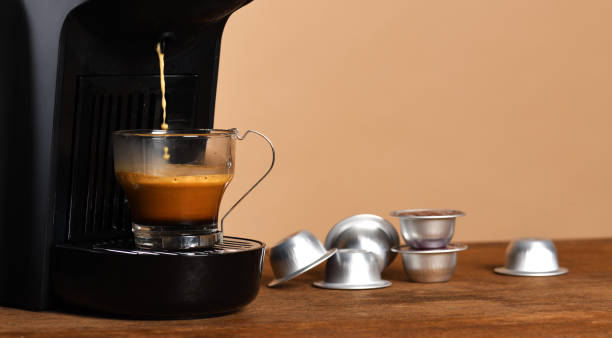It’s hard to imagine a world without capsule coffee machines, but they’re actually a relatively new development in the coffee world. The first capsule coffee machine was introduced by Nestlé in 1976, and it wasn’t until the late 1980s and early 1990s that other companies started to develop their own versions. In this article, we’ll explore the history of capsule coffee machines and how they’ve evolved over the years.

The First Capsule Coffee Machine
The first capsule coffee machine was called the Nespresso, and it was invented by Eric Favre, an employee of Nestlé. The Nespresso machine used specially designed aluminum capsules that were filled with coffee grounds and sealed with a foil lid. When the capsule was inserted into the machine and the button was pressed, hot water was forced through the capsule and into a cup, producing a fresh cup of coffee.
Initially, the Nespresso was marketed as a luxury product, with a high price tag and limited availability. But it quickly gained popularity in Europe, and in the 1990s, Nestlé began to expand the brand into other markets.
The Rise of Capsule Coffee Machines
In the late 1980s and early 1990s, other companies began to develop their own versions of the capsule coffee machine. Lavazza, Illy, and Keurig were among the first to introduce their own machines, each with their own unique features and design. Lavazza’s machine, for example, used a pre-packaged filter that was inserted into the machine, while Keurig’s machine used plastic pods that could be filled with a variety of coffee blends.
As more companies entered the market, the popularity of capsule coffee machines continued to grow. By the early 2000s, Nespresso had become one of the most popular brands in Europe, and in 2006, they opened their first boutique store in Paris. Other brands, such as Tassimo and Dolce Gusto, also began to gain popularity, offering a wider range of drinks, including tea and hot chocolate.
Today, capsule coffee machines are widely available around the world, with dozens of brands and hundreds of flavors to choose from. Some machines are designed for home use, while others are designed for commercial use in restaurants, hotels, and offices. And while the basic design of the machine has remained the same, there have been several developments and improvements over the years.
Evolution of Capsule Coffee Machines
One of the biggest improvements to capsule coffee machines has been the development of the milk frother. In the early days of capsule coffee machines, the only way to make a latte or cappuccino was to heat up milk in a separate container and pour it over the coffee. But as the popularity of these drinks grew, manufacturers began to develop machines that could froth milk automatically, creating a more convenient and consistent experience.
Another major development has been the introduction of reusable capsules. In the early days of capsule coffee machines, each brand had their own proprietary capsule, and you could only use that brand’s capsules in their machine. But as consumers began to demand more flexibility, manufacturers started to develop reusable capsules that could be used with any brand of coffee.
Looking to the Future
So what’s next for capsule coffee machines? There are a few exciting developments on the horizon. For example, some manufacturers are exploring the use of biodegradable materials for their capsules, making them more eco-friendly. Others are experimenting with new brewing methods, such as cold brew and nitro brew, that could open up a whole new world of flavors and possibilities.
The history of capsule coffee machines is a story of innovation and convenience, and it’s fascinating to see how they’ve evolved over the years. These machines have revolutionized the way we enjoy coffee, and it’s exciting to think about what the future might hold.




